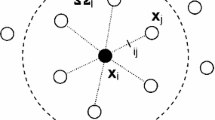Abstract
The intensity variation in a scanning electron microscope is a complex function of sample topography and composition. Measurement accuracy is improved when an explicit accounting for the relationship between signal and measurand is made. Because the determinants of the signal are many, the theoretical understanding usually takes the form of a simulator. For samples with nonconducting regions that charge, one phase of the simulation is finite element analysis to compute the electric field. The size of the finite element mesh, and consequently computation time, can be reduced through the use of adaptive mesh refinement. We present a new a posteriori local error estimator and adaptive mesh refinement algorithm for the scanning electron microscope simulation. This error estimate is designed to minimize the error in the electron trajectories, rather than the energy norm of the error that traditional error estimators minimize. Using a test problem with a known exact solution, we show that the adaptive mesh can achieve the same error in electron trajectories as a carefully designed hand-graded mesh while using 3.5 times fewer vertices and 2.25 times less computation time.









Similar content being viewed by others
Notes
The mention of specific products, trademarks, or brand names is for purposes of identification only. Such mention is not to be interpreted in any way as an endorsement or certification of such products or brands by the National Institute of Standards and Technology. All trademarks mentioned herein belong to their respective owners.
References
Ainsworth, M., Oden, J.T.: A Posteriori Error Estimation in Finite Element Analysis. Wiley,New York (2000)
Arnold, D.N., Mukherjee, A., Pouly, L.: Locally adapted tetrahedral meshes using bisection. SIAM J. Sci. Comput. 22, 431–448 (2000)
Bank, R.E., Weiser, A.: Some a posteriori error estimators for elliptic partial differential equations. Math. Comput. 44, 283–301 (1985)
Ciappa, M., Illarionov, A.Y., Ilguensatiroglu, E.: Exact 3D simulation of scanning electron microscopy images of semiconductor devices in the presence of electric and magnetic fields. Microelectron. Reliab. 54, 2081–2087 (2014)
Egerton, R.F., Li, P., Malac, M.: Radiation damage in the TEM and SEM. Micron 35, 399 (2004)
Geuzaine, C., Remacle, J.F.: Gmsh: a three-dimensional finite element mesh generator with built-in pre- and post-processing facilities. Int. J. Numer. Methods Eng. 79(11), 1309–1331 (2009)
Goldstein, J., Newbury, D.E., Joy, D.C., Lyman, C.E., Echlin, P., Lifshin, E., Sawyer, L., Michael, J.R.: Scanning Electron Microscopy and X-ray Microanalysis: \(3^{rd}\) Edition. Springer, New York (2003)
Grella, L., Difabrizio, E., Gentili, M., Baciocchi, M., Mastrogiacomo, L., Maggiora, R., Capodicci, L.: Secondary-electron line scans over high-resolution resist images—theoretical and experimental investigation of induced local electrical-field effects. J. Vac. Sci. Technol. B 12, 3555–3560 (1994)
Grella, L., Lorusso, G., Niemi, T., Adler, D.L.: Simulations of SEM imaging and charging. Nucl. Instrum. Methods Phys. Res. A 519, 242–250 (2004)
Grogan, J.M., Schneider, N.M., Ross, F.M., Bau, H.H.: Bubble and pattern formation in liquid induced by an electron beam. Nano Lett. 14, 359 (2014)
McCord, M.A., Rooks, M.J.: SPIE Handbook of Microlithography, Micro-machining and Microfabrication, Volume 1: Microlithography. SPIE Optical Engineering Press, Bellingham (1997)
Mitchell, W.F.: 30 years of newest vertex bisection. J. Numer. Anal. Ind. Appl. Math. 11, 11–22 (2017)
Mitchell, W.F.: PHAML home page. http://math.nist.gov/phaml (2017). Accessed 27 Sept 2017
Verfürth, R.: A Review of a posteriori Error Estimation and Adaptive Mesh Refinement Techniques. Wiley Teubner, Chichester (1996)
Villarrubia, J.S., Ritchie, N.W.M., Lowney, J.R.: Monte carlo modeling of secondary electron imaging in three dimensions. In: Proceedings of the SPIE vol. 6518 (2007)
Villarrubia, J.S., Vladár, A.E., Postek, M.T.: 3D Monte Carlo modeling of the SEM: Are there applications to photomask metrology? Proc. SPIE 9236, 923602 (2014)
Villarrubia, J.S., Vladár, A.E., Ming, B., Kline, R.J., Sunday, D.F., Chawla, J.S., List, S.: Scanning electron microscope measurement of width and shape of 10 nm patterned lines using a JMONSEL-modeled library. Ultramicroscopy 154, 15–28 (2015)
Author information
Authors and Affiliations
Corresponding author
Additional information
Publisher's Note
Springer Nature remains neutral with regard to jurisdictional claims in published maps and institutional affiliations.
Official contribution of the National Institute of Standards and Technology; not subject to copyright in the United States.
Rights and permissions
About this article
Cite this article
Mitchell, W.F., Villarrubia, J.S. An a Posteriori Error Estimate for Scanning Electron Microscope Simulation with Adaptive Mesh Refinement. J Sci Comput 80, 1700–1715 (2019). https://doi.org/10.1007/s10915-019-00995-2
Received:
Revised:
Accepted:
Published:
Issue Date:
DOI: https://doi.org/10.1007/s10915-019-00995-2
Keywords
- Adaptive mesh refinement
- A posteriori error estimation
- Scanning electron microscope simulation
- Finite element analysis




